Rod Pinkston | Originally published in GameKeepers: Farming for Wildlife Magazine. To subscribe, click here.
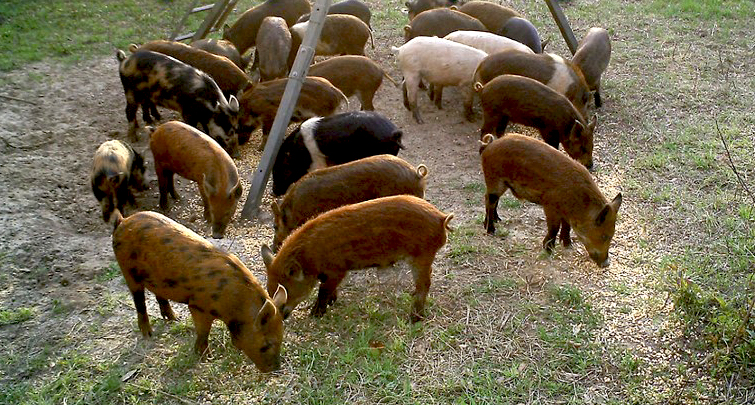
Integrated Wild Pig Control™ (IWPC™) is a strategic approach using a series of innovative control methods and technologies implemented in a specific sequence based on seasonal food sources. Emphasis is placed on the efficient removal of the entire sounder at one time to eliminate escapes and education. In the past two issues, we covered high-volume winter trapping tactics necessary to eliminate 70-80 percent of the total property population and spring strategies of thermal shooting operations at night to target an additional 10-20 percent of feral hots. The IWPC™ summer strategy will focus on eliminating the remaining 10 percent of the population.
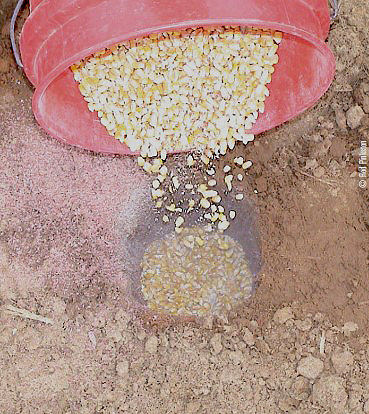
works well to put soured corn in for a “quick reaction
force” bait site.
It is important to remember the final 10 percent of feral hogs on the property have already avoided capture from six-panel corral traps with 8-foot wide thresholds and survived previous shooting engagements at night. The remaining pigs have a higher intelligence quotient (IQ) because they have been educated from earlier failed attempts. Therefore, the seasonal control strategy must also change to target their summer wallows, pine rubs, water sources, food sources, and trails. The total time and labor needed to remove the final 10 percent of the population may require a higher number of hours used to remove the first 90 percent.
Targeting the remaining population requires effective reconnaissance and intelligence gathering by strategically locating 10 to 15 high definition video cameras on every 250 acres. Operators must first identify the number and location of the survivors and document their nightly patterns before choosing the appropriate summer control strategy. We will cover three innovative methods to better understand the technologies needed to execute an effective ambush trap, a QRF bait hole and a technique known as Dumbing The Sounder™.
JAGER PRO recently removed over 500 feral hogs from 5,000 acres surrounding Pennahatchee Creek in Dooly County, Georgia. These pigs had been trapped extensively with five-foot by eight-foot box traps for three consecutive years prior to our company receiving the contract. Adult sows had been educated to avoid these small, portable traps after experiencing multiple juvenile captures and were teaching their offspring through vocalization at our corral trap locations to avoid large, metal contraptions as well. The following methods and technologies were used to effectively reduce this highly educated population to zero.
Dumbing The Sounder™ is a technique used to surgically remove all adults from the sounder via thermal shooting operations before erecting a M.I.N.E.™ (Manually Initiated Nuisance Elimination™) Trapping System to efficiently capture the juveniles. Start the process by creating a standard bait site using a tripod feeder with a digital timer set to spin every evening at dusk. This begins the process of conditioning the sounder to trust the feeder as a daily food source. Bait sites should always be considered a shooting sanctuary meaning you should never shoot pigs in the 100 acres surrounding the feeder. The objective is to strategically remove every adult during a single stalk with multiple thermal shooters when the sounder is located outside the 100-acre sanctuary.
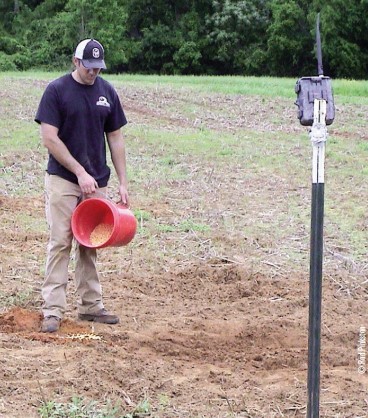
taken using a “quick reaction force” responding to
triggered cameras at strategically placed bait sites.
Let the juveniles return to the sanctuary bait site at least once to feed before erecting the six-panel M.I.N.E.™ Trapping System. This feeding should accomplish two goals. The first is to reinforce the bait location is safe without their mothers and the second is to record video intelligence of their juvenile behavior while providing an updated body count. This information is crucial to ensure 100 percent capture results are obtained after the trap enclosure is built. The M.I.N.E.™ Camera sends text photos to your cell phone when the PIR motion sensor detects movement inside the trap and then remotely controls the M.I.N.E.™ Gate via a cell text from the comfort of your home or office. The entire juvenile sounder is often captured the first night since there are no adult sows to vocalize “danger” at the trap enclosure.
Ambush traps are designed to use natural terrain or fencing as a choke point to control sounder movement patterns around food or water sources. It is nearly impossible to convince a trap-shy adult to willingly enter a trap threshold. The best way to achieve success is by installing the gate as part of established fencing around a field or food plot. Waterways, streams, and culverts are natural low areas for feral hogs to squeeze under an existing fence and make perfect locations to erect an ambush trap.
We have also experienced success by temporarily erecting 100 yards of 18-60™ Panels along a crop damaged agricultural field being destroyed as a food source. Start by placing an open 8-foot-wide M.I.N.E.™ Gate in the trail from the bedding area to the cornfield with 50 yards of fencing on either side. The pigs quickly learn to enter and exit the field through the 8-foot-wide opening to feed each night. Video camera information will reveal how many pigs are in the sounder, how long to enter through the gate threshold, when they arrive and when they depart each morning.
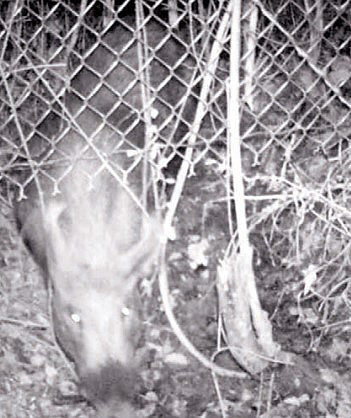
willingly enter a trap threshold. The best way to
achieve success is by installing the gate as part of
established fencing around a field or food plot that
they are already using.
This scenario creates a perfect fatal funnel to erect a large 10-panel enclosure with panels disappearing into the standing corn stalks. A 13-foot-tall tripod stand should be located downwind of the trail to enable an operator to observe the entire sounder with a thermal monocular as they walk down the trail. The gate is closed with a handheld transmitter after the sounder crosses the trap threshold into the cornfield.
Quick Reaction Force or (QRF) is a military term referring to a specialized unit capable of rapid response to a situation, typically within ten minutes or less. We successfully utilize this strategy in the form of QRF bait holes to eliminate single adult boars or sows who have previously avoided traps and tripod feeders. Start by digging a 9-inch-diameter hole approximately 18 feet deep with a post-hole digger along a well-used trail. Bait site location is very important since the primary objective is to shoot single adults at night inside 100 yards. The QRF bait holes must be quietly accessible from multiple wind directions to be effective. Fill the 18-foot-deep hole with soured corn to provide aroma and cover with dirt to discourage deer and raccoons from visiting the site. Intelligent survivor boars and sows are more comfortable digging soured bait from the ground than standing under a feeder. Rooting will take them several hours to reach the bottom of the hole providing shooters ample time to react.
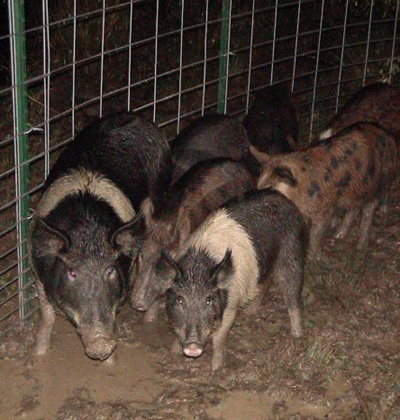
pigs that have eluded traps and thermal shooting
operations. It means you may need to be relentless and
sneaky.
Place an I.C.E.™ Camera (Intel Collecting Equipment™) overlooking the bait site on a T-post. The I.C.E.™ Camera is a wireless cellular camera that sends text photos to a cell phone when the PIR motion sensor detects movement. Each QRF bait hole is built to strategically target an individual adult detected from previous high definition video reconnaissance. QRF personnel are equipped with AR-10 platform rifles in .308 caliber topped with 640 x 480 resolution thermal scopes. Shooters are staged in a central location from multiple bait holes at dusk with wind direction being the most important consideration. Cell phones are monitored all night for incoming text photos from multiple I.C.E.™ Cameras which are sent within seconds of motion at the bait hole. Upon positive identification of a pig, shooters quietly move with the wind in their face to the appropriate bait site to dispatch the target.
These strategic control methods and technologies save fuel, time and labor allowing 24-hour surveillance at multiple locations and allow the ability to obtain 100 percent removal success on your property. As wild pig populations continue to grow, we must refine and implement alternative control methods to solve the problem. Innovative landowners and wildlife managers with modern equipment and high volume removal methods will play a critical role in effectively managing future wild pig populations.































